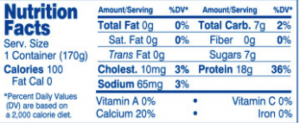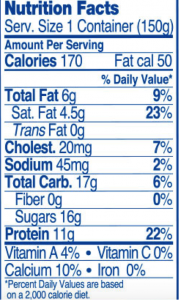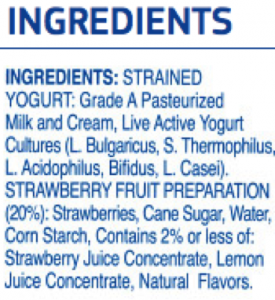 We all know that we should limit sugar in our diets, but it can be difficult to decipher ingredients and food labels. It isn’t wise to eliminate all sugar from our diet (fruits, vegetables, and dairy products contain naturally occurring sugars), but we should limit the added sugar in our diet (anything we add to food to make it sweeter).
We all know that we should limit sugar in our diets, but it can be difficult to decipher ingredients and food labels. It isn’t wise to eliminate all sugar from our diet (fruits, vegetables, and dairy products contain naturally occurring sugars), but we should limit the added sugar in our diet (anything we add to food to make it sweeter).
Here is a quick summary of how to find added sugars in your food (please note this does NOT include a discussion of artificial sweeteners):
Added sugars are any sugars or sweeteners that are added to food. Period. From your body chemistry perspective, it does not matter if the sugars are “natural” or “processed”; your body absorbs the sugar, breaks it down, and it raises your blood sugar. Added sugars include plain white sugar, brown sugar, honey, molasses, maple syrup, agave, evaporated cane juice, raw sugar, brown rice syrup, and high fructose corn syrup. Note that some of these sugars are highly processed (plain white sugar, high fructose corn syrup), and some are available in their most natural form (honey, maple syrup). Although the natural forms of sugar may indeed be natural, studies show that your body sees both natural and processed sugars as sugar. Period. Any of these added to your foods will raise your blood sugar level. In other words, if you want to sweeten your tea, your blood sugar level will rise whether you use a teaspoon of plain old white sugar, honey, or agave.
Naturally occurring sugars are sugars that are found in foods in nature. Note that “natural” sugars are different from “naturally occurring sugars”. These sugars include lactose in dairy products and fructose in fruits and vegetables. These sugars also raise your blood sugar level, but may do so more slowly because they come in a package (the fruit, vegetable, or dairy product itself is the package) that also contains fiber and protein. Because of the protein and fiber, your body will absorb the naturally occurring sugars more slowly and your blood sugar level will not spike and then crash. Foods with naturally occurring sugars also come with valuable nutrients such as vitamins and minerals. Thus, there are nutritional benefits to eating naturally occurring sugars.
One good way to understand the difference is to look at two containers of Greek yogurt at the grocery store. Both are single serving cups of Fage Greek yogurt. One is just plain yogurt, the other has strawberry filling to mix into the yogurt. Note that due to packaging, the plain yogurt container holds a slightly larger amount of yogurt than the flavored yogurt package (170g versus 150g)
Plain Greek yogurt label.
Strawberry Greek yogurt label.
The label on plain Greek yogurt shows 7 g of sugar per 170g of yogurt. The label on strawberry flavored Greek yogurt shows 16 g of sugar per 150 g of yogurt. That is a lot more sugar in the flavored variety, right?
But maybe it is just the strawberry puree that makes it have more sugar, and we just said that naturally occurring sugars contain good stuff like fiber and minerals! How can we tell if those extra grams of sugar in the flavored yogurt are added sugars or naturally occurring sugars?
In August of 2016 the FDA passed a rule that requires food labels list exactly that-the added sugars in food. Therefore, food labels are now required to list both the total grams of sugar AND the grams of ADDED sugar. However, the compliance date for manufacturers to follow this rule is July 26, 2018. So until then, how do we know if there is added sugar in our food?
For now, we need to go back to the label to read the list of ingredients. Here is the list of ingredients for the strawberry flavored yogurt:
The ingredients look great until the strawberry puree. By reading the ingredients we can see that there are indeed raspberries (great!), but also pure cane sugar (a source of added sugar). Thus, the healthier choice would be to get the plain yogurt and mix in your own fresh raspberries!
*Please note that this discussion of sugar applies to people without diabetes or other health conditions. If you have diabetes or other health conditions, talk to your health care provider for information on following a diet that is right for your specific health needs.



